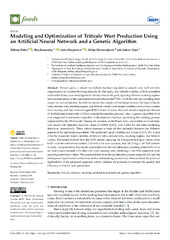Приказ основних података о документу
Modeling and Optimization of Triticale Wort Production Using an Artificial Neural Network and a Genetic Algorithm
| dc.creator | Pribić, Milana | |
| dc.creator | Kamenko, Ilija | |
| dc.creator | Despotović, Saša | |
| dc.creator | Mirosavljević, Milan | |
| dc.creator | Pejin, Jelena | |
| dc.date.accessioned | 2024-02-06T13:13:16Z | |
| dc.date.available | 2024-02-06T13:13:16Z | |
| dc.date.issued | 2024 | |
| dc.identifier.issn | 2304-8158 | |
| dc.identifier.uri | http://fiver.ifvcns.rs/handle/123456789/4234 | |
| dc.description.abstract | Triticale grain, a wheat–rye hybrid, has been reported to comply very well with the requirements for modern brewing adjuncts. In this study, two triticale varieties, in both unmalted and malted forms, were investigated at various ratios in the grist, applying different mashing regimes and concentrations of the commercial enzyme Shearzyme® 500 L with the aim of evaluating their impact on wort production. In order to capture the complex relationships between the input (triticale ratio, enzyme ratio, mashing regime, and triticale variety) and output variables (wort extract content, wort viscosity, and free amino nitrogen (FAN) content in wort), the study aimed to implement the use of artificial neural networks (ANNs) to model the mashing process. Also, a genetic algorithm (GA) was integrated to minimize a specified multi-objective function, optimizing the mashing process represented by the ANN model. Among the solutions on the Pareto front, one notable set of solutions was found with objective function values of 0.0949, 0.0131, and 1.6812 for the three conflicting objectives, respectively. These values represent a trade-off that optimally balances the different aspects of the optimization problem. The optimized input variables had values of 23%, 9%, 1, and 3 for the respective input variables of triticale ratio, enzyme ratio, mashing regime, and triticale variety. The results derived from the ANN model, applying the GA-optimized input values, were 8.65% w/w for wort extract content, 1.52 mPa·s for wort viscosity, and 148.32 mg/L for FAN content in wort. Comparatively, the results conducted from the real laboratory mashing were 8.63% w/w for wort extract content, 1.51 mPa·s for wort viscosity, and 148.88 mg/L for FAN content in wort applying same input values. The presented data from the optimization process using the GA and the subsequent experimental verification on the real mashing process have demonstrated the practical applicability of the proposed approach which confirms the potential to enhance the quality and efficiency of triticale wort production. | sr |
| dc.language.iso | en | sr |
| dc.publisher | Basel : MDPI | sr |
| dc.relation | info:eu-repo/grantAgreement/MESTD/inst-2020/200134/RS// | sr |
| dc.relation | info:eu-repo/grantAgreement/MESTD/inst-2020/200116/RS// | sr |
| dc.rights | openAccess | sr |
| dc.rights.uri | https://creativecommons.org/licenses/by/4.0/ | |
| dc.source | Foods - Basel | sr |
| dc.subject | triticale | sr |
| dc.subject | adjuncts | sr |
| dc.subject | mashing | sr |
| dc.subject | artificial neural networks | sr |
| dc.subject | genetic algorithms | sr |
| dc.title | Modeling and Optimization of Triticale Wort Production Using an Artificial Neural Network and a Genetic Algorithm | sr |
| dc.type | article | sr |
| dc.rights.license | BY | sr |
| dc.citation.issue | 2 | |
| dc.citation.spage | 343 | |
| dc.citation.volume | 13 | |
| dc.identifier.doi | 10.3390/foods13020343 | |
| dc.identifier.fulltext | http://fiver.ifvcns.rs/bitstream/id/10063/bitstream_10063.pdf | |
| dc.type.version | publishedVersion | sr |


